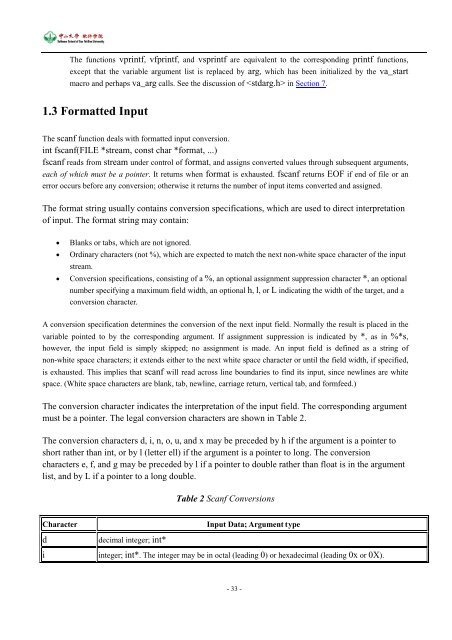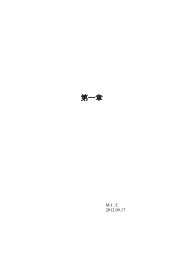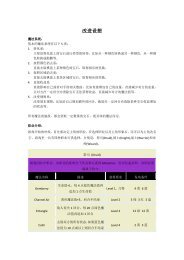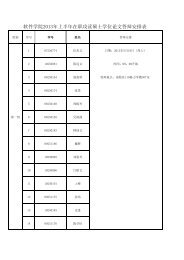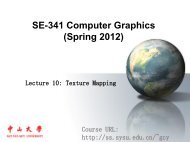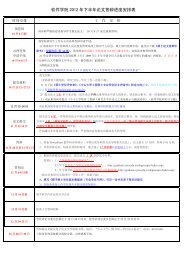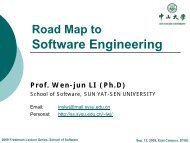C 语言程序设计(I)实验手册 - 中山大学软件学院
C 语言程序设计(I)实验手册 - 中山大学软件学院
C 语言程序设计(I)实验手册 - 中山大学软件学院
You also want an ePaper? Increase the reach of your titles
YUMPU automatically turns print PDFs into web optimized ePapers that Google loves.
The functions vprintf, vfprintf, and vsprintf are equivalent to the corresponding printf functions,<br />
except that the variable argument list is replaced by arg, which has been initialized by the va_start<br />
macro and perhaps va_arg calls. See the discussion of in Section 7.<br />
1.3 Formatted Input<br />
The scanf function deals with formatted input conversion.<br />
int fscanf(FILE *stream, const char *format, ...)<br />
fscanf reads from stream under control of format, and assigns converted values through subsequent arguments,<br />
each of which must be a pointer. It returns when format is exhausted. fscanf returns EOF if end of file or an<br />
error occurs before any conversion; otherwise it returns the number of input items converted and assigned.<br />
The format string usually contains conversion specifications, which are used to direct interpretation<br />
of input. The format string may contain:<br />
• Blanks or tabs, which are not ignored.<br />
• Ordinary characters (not %), which are expected to match the next non-white space character of the input<br />
stream.<br />
• Conversion specifications, consisting of a %, an optional assignment suppression character *, an optional<br />
number specifying a maximum field width, an optional h, l, or L indicating the width of the target, and a<br />
conversion character.<br />
A conversion specification determines the conversion of the next input field. Normally the result is placed in the<br />
variable pointed to by the corresponding argument. If assignment suppression is indicated by *, as in %*s,<br />
however, the input field is simply skipped; no assignment is made. An input field is defined as a string of<br />
non-white space characters; it extends either to the next white space character or until the field width, if specified,<br />
is exhausted. This implies that scanf will read across line boundaries to find its input, since newlines are white<br />
space. (White space characters are blank, tab, newline, carriage return, vertical tab, and formfeed.)<br />
The conversion character indicates the interpretation of the input field. The corresponding argument<br />
must be a pointer. The legal conversion characters are shown in Table 2.<br />
The conversion characters d, i, n, o, u, and x may be preceded by h if the argument is a pointer to<br />
short rather than int, or by l (letter ell) if the argument is a pointer to long. The conversion<br />
characters e, f, and g may be preceded by l if a pointer to double rather than float is in the argument<br />
list, and by L if a pointer to a long double.<br />
Table 2 Scanf Conversions<br />
Character<br />
Input Data; Argument type<br />
d<br />
i<br />
decimal integer; int*<br />
integer; int*. The integer may be in octal (leading 0) or hexadecimal (leading 0x or 0X).<br />
- 33 -


